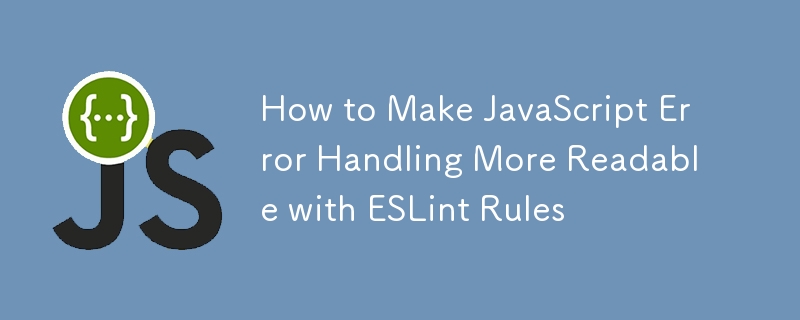Heim >Web-Frontend >js-Tutorial >So machen Sie die JavaScript-Fehlerbehandlung mit ESLint-Regeln lesbarer
So machen Sie die JavaScript-Fehlerbehandlung mit ESLint-Regeln lesbarer
- DDDOriginal
- 2024-10-09 06:20:29504Durchsuche

Pengenalan: Menguasai Pengendalian Ralat dalam JavaScript
Pengendalian ralat yang berkesan adalah penting untuk mana-mana aplikasi JavaScript yang mantap. Ia membantu dalam pengenalan isu pantas, memudahkan penyahpepijatan dan meningkatkan kebolehpercayaan perisian. Panduan ini menyelidiki dalam meningkatkan pengendalian ralat JavaScript melalui ESLint, alat yang menguatkuasakan kualiti kod dan menyeragamkan amalan pengendalian ralat.
Mengapa Fokus pada Pengendalian Ralat Boleh Dibaca?
Pengendalian ralat boleh dibaca memberikan cerapan segera tentang isu, membantu pembangun memahami dan menyelesaikan masalah dengan cekap. Amalan ini penting dalam persekitaran pasukan dan penting untuk mengekalkan kod dalam jangka panjang.
Melaksanakan Amalan Pengendalian Ralat yang Lebih Baik
Untuk meningkatkan pengendalian ralat JavaScript anda, pertimbangkan strategi berikut:
1. Gunakan Try-Catch Blocks dengan Berkesan
try {
const data = JSON.parse(response);
console.log(data);
} catch (error) {
console.error("Failed to parse response:", error);
}
2. Bangunkan Kelas Ralat Tersuai
class ValidationError extends Error {
constructor(message) {
super(message);
this.name = "ValidationError";
}
}
try {
throw new ValidationError("Invalid email address");
} catch (error) {
console.error(error.name, error.message);
}
3. Pastikan Pengelogan Ralat Terperinci
function handleError(error) {
console.error(`${new Date().toISOString()} - Error: ${error.message}`);
}
4. Bezakan Fungsi Balingan dan Bukan Balingan
Versi melontar:
function calculateAge(dob) {
if (!dob) throw new Error("Date of birth is required");
}
Versi tanpa melontar:
function tryCalculateAge(dob) {
if (!dob) {
console.error("Date of birth is required");
return null;
}
}
Menguatkuasakan Pengendalian Ralat dengan ESLint
Menyediakan ESLint untuk menguatkuasakan amalan ini melibatkan langkah dan konfigurasi berikut:
1. Pasang dan Sediakan ESLint
npm install eslint --save-dev npx eslint --init
2. Konfigurasikan Peraturan ESLint untuk Pengendalian Ralat
Pengendalian ralat yang berkesan adalah penting untuk membangunkan aplikasi JavaScript yang mantap. Di bawah ialah peraturan ESLint yang boleh membantu menguatkuasakan amalan pengendalian ralat yang baik dalam pangkalan kod anda.
1. No Unhandled Promises
- Rule:
"promise/no-return-in-finally": "warn", "promise/always-return": "error"
- Explanation: This configuration ensures that promises always handle errors and don’t unintentionally suppress returned values in finally blocks.
2. No Await Inside a Loop
- Rule:
"no-await-in-loop": "error"
- Explanation: Awaits inside loops can lead to performance issues, as each iteration waits for a promise to resolve sequentially. It's better to use Promise.all() for handling multiple promises.
- Example:
// Incorrect
async function processArray(array) {
for (let item of array) {
await processItem(item);
}
}
// Correct
async function processArray(array) {
const promises = array.map(item => processItem(item));
await Promise.all(promises);
}
3. Proper Error Handling in Async Functions
- Rule:
"promise/catch-or-return": "error", "async-await/space-after-async": "error"
- Explanation: Enforce that all asynchronous functions handle errors either by catching them or by returning the promise chain.
4. Consistent Return in Functions
- Rule:
"consistent-return": "error"
- Explanation: This rule enforces a consistent handling of return statements in functions, making it clear whether functions are expected to return a value or not, which is crucial for error handling and debugging.
5. Disallowing Unused Catch Bindings
- Rule:
"no-unused-vars": ["error", {"args": "none"}],
"no-unused-catch-bindings": "error"
- Explanation: Ensures that variables declared in catch blocks are used. This prevents ignoring error details and encourages proper error handling.
6. Enforce Throwing of Error Objects
- Rule:
"no-throw-literal": "error"
- Explanation: This rule ensures that only Error objects are thrown. Throwing literals or non-error objects often leads to less informative error messages and harder debugging.
- Example:
// Incorrect
throw 'error';
// Correct
throw new Error('An error occurred');
7. Limiting Maximum Depth of Callbacks
- Rule:
"max-nested-callbacks": ["warn", 3]
- Explanation: Deeply nested callbacks can make code less readable and error-prone. Limiting the nesting of callbacks encourages simpler, more maintainable code structures.
8. Avoiding Unused Expressions in Error Handling
- Rule:
"no-unused-expressions": ["error", {"allowShortCircuit": true, "allowTernary": true}]
- Explanation: This rule aims to eliminate unused expressions which do not affect the state of the program and can lead to errors being silently ignored.
9. Require Error Handling in Callbacks
- Rule:
"node/handle-callback-err": "error"
- Explanation: Enforces handling error parameters in callbacks, a common pattern in Node.js and other asynchronous JavaScript code.
10. Disallowing the Use of Console
- Rule:
"no-console": "warn"
- Explanation: While not strictly an error handling rule, discouraging the use of console helps in avoiding leaking potentially sensitive error details in production environments and encourages the use of more sophisticated logging mechanisms.
3. Integrate ESLint into Your Development Workflow
Ensure ESLint runs automatically before code commits or during CI/CD processes.
Conclusion: Enhancing Code Quality with ESLint
By adopting these ESLint rules and error-handling strategies, you elevate the readability and reliability of your JavaScript applications. These improvements facilitate debugging and ensure a smoother user experience.
Final Thought
Are you ready to transform your error handling approach? Implement these practices in your projects to see a significant boost in your development efficiency and code quality. Embrace these enhancements and lead your projects to success.
Das obige ist der detaillierte Inhalt vonSo machen Sie die JavaScript-Fehlerbehandlung mit ESLint-Regeln lesbarer. Für weitere Informationen folgen Sie bitte anderen verwandten Artikeln auf der PHP chinesischen Website!
In Verbindung stehende Artikel
Mehr sehen- Eine eingehende Analyse der Bootstrap-Listengruppenkomponente
- Detaillierte Erläuterung des JavaScript-Funktions-Curryings
- Vollständiges Beispiel für die Generierung von JS-Passwörtern und die Erkennung der Stärke (mit Download des Demo-Quellcodes)
- Angularjs integriert WeChat UI (weui)
- Wie man mit JavaScript schnell zwischen traditionellem Chinesisch und vereinfachtem Chinesisch wechselt und wie Websites den Wechsel zwischen vereinfachtem und traditionellem Chinesisch unterstützen – Javascript-Kenntnisse

